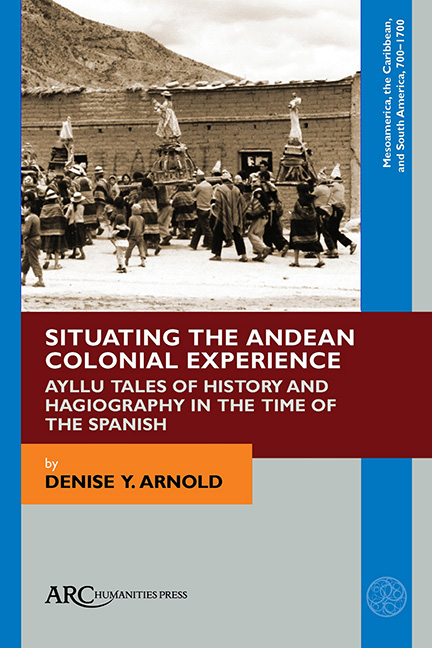 Situating the Andean Colonial Experience
Situating the Andean Colonial Experience Book contents
- Frontmatter
- Contents
- List of Illustrations
- Note About the Spelling of Toponyms and Proper Names
- Acknowledgements
- Maps
- Introduction
- PART ONE THE ORAL HISTORY OF QAQACHAKA
- PART TWO THE COLONIAL CACIQUES IN ORAL AND WRITTEN HISTORY
- PART THREE QAQACHAKA MARKA
- PART FOUR THE SAINTS APPEAR
- PART FIVE THE RELIGIOUS PRACTICES OF QAQACHAKA MARKA
- Some Conclusions
- Glossary
- Appendix A Document C of Don Franco Quispe Maraza
- Appendix B Document K of Don Franco Quispe Maraza
- Bibliography
- Thematic Index
- Index of Toponyms
Chapter 6 - Some Clarifications about Juana Doña Ana and her Kinsfolk
Published online by Cambridge University Press: 22 June 2021
- Frontmatter
- Contents
- List of Illustrations
- Note About the Spelling of Toponyms and Proper Names
- Acknowledgements
- Maps
- Introduction
- PART ONE THE ORAL HISTORY OF QAQACHAKA
- PART TWO THE COLONIAL CACIQUES IN ORAL AND WRITTEN HISTORY
- PART THREE QAQACHAKA MARKA
- PART FOUR THE SAINTS APPEAR
- PART FIVE THE RELIGIOUS PRACTICES OF QAQACHAKA MARKA
- Some Conclusions
- Glossary
- Appendix A Document C of Don Franco Quispe Maraza
- Appendix B Document K of Don Franco Quispe Maraza
- Bibliography
- Thematic Index
- Index of Toponyms
Summary
Doña Ana was tall, because women from those times were tall … And in her footsteps the high mountains settled themselves down …
Doña Bernaldita Quispe, from the hamlet of QañawiA GOOD CONTRAST with the tales by Don Franco and the members of his immediate family is the following sequence of narratives about Qaqachaka history told by Doña Bernaldita Quispe, which we recorded in 1993. I already mentioned that Doña Bernaldita Quispe was the granddaughter of another important title-bearer, Mallku Mariano Quispe from ayllu Sullkayana. So, during her early childhood, she must have had the opportunity to hear her grandfather's recitations by memory about the contents of the historical documents in his charge.
However, there are some aspects to her narratives I wish to underline. The first is that her grasp of the oral history of the place is not the same as the more detailed knowledge of the title-bearers themselves. As part of the local “textual community” (Rappaport 1990), they recorded from memory impressively long extracts from the contents of the historical documents in their possession in order to recite these aloud. By contrast, Doña Bernaldita's own memories combine certain aspects derived from written documents and the tradition of the title-bearers with other more mythical and interpretative aspects drawn from oral history. In regard to this first aspect, some of her interpretations make me think that Doña Bernaldita had a certain influence from the Evangelists of the place, or perhaps a period of formal teaching in Catholic doctrine, possibly when she carried out the customary service with her husband of living in the residence of the curate from Condo during the month prior to their marriage. The second aspect is that, as compared to the narratives by the title-bearers themselves, all men, Doña Bernaldita's tales privilege the agency of the female actors in Qaqachaka history.
Because of this feminine bent, our conversation with her could concentrate on two of the first key female ancestors of Qaqachaka and their many feats, which other narrators mention just in passing, namely Juana Doña Ana and her sister, Inka Mariya. We learn from Doña Bernaldita that Juana Doña Ana was a woman from Qaqachaka itself, a widow and daughter of a title-bearer, who herself had “great ideas.”
- Type
- Chapter
- Information
- Situating the Andean Colonial ExperienceAyllu Tales of History and Hagiography in the Time of the Spanish, pp. 103 - 114Publisher: Amsterdam University PressPrint publication year: 2021
